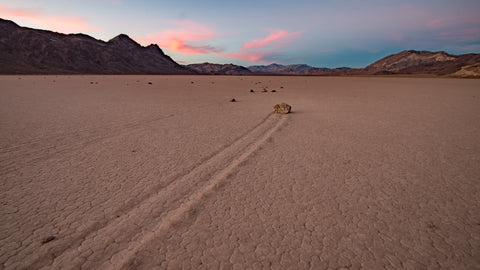Amongst the sprawling Last Chance mountain range and the hiking trails of the Cottonwood in Death Valley is a dry lakebed known as the Racetrack. This stretch of desert domain grows no vegetarian yet folks often venture out to witness the ongoing races that have given the area its name.
No need to start your engines. You can leave your four wheel drive and all-terrain vehicles parked in the driveway; the contestants here require no automotive assistance as they sail about the track. The vehicles? A motley crew of hundreds of stones and boulders (some as heavy as 320 kilograms or 700 pounds) that seemingly move about the flattened desert region all on their own, leaving a trail of dust and dirt behind them.
They are known as the sailing stones of death valley.

After eroding off of and tumbling down from the surrounding mountains, rocks and boulders find their starting position on the bevelled parched floor of the Racetrack Playa. Playa, coming from the Spanish word for shore or beach, refers to an area of flat dried-up land, most often found in desert climates like the one in Death Valley.
So what’s so special about these stones?
The sailing stones got their name because of the odd natural phenomena that causes them to sail about the desert, all on their own. They propel forward through the dry lands of the Racetrack, leaving behind a visible trail as their heavy bodies of rock drag along the surface.
For many years, the mystery of the sailing stones remained unsolved. Were these pieces of earth and stone actually some sort of unknown creature that moved about the desert on their own accord? Were there other beings or forces here at play?
Well, it turns out that there is a much simpler answer.

The Mystery Unravelled
The fact of the matter is, researchers have been trying to find an explanation for the stones since the 1940s but they’ve all come up empty handed. This could be due to the fact that the stones can lay dormant for decades at a time, with no movement seen for many many years. It’s hard to study a phenomena when it doesn’t happen consistently and when there’s no known way to predict when the next occurrence will be.
But sometimes a little bit of luck goes a long way.
In August of 2014 paleobiologist Richard Norris of the Scripps Institution of Oceanography, UC San Diego published an article on the sailing stones and the Death Valley mystery, claiming to have seen the stones in action for the very first time.
After having set up equipment that would allow them to watch the stones remotely, while also monitoring the weather, the research team hunkered down, expecting this to be an agonisingly slow and possibly even fruitless effort. The research itself was even referred to as "the most boring experiment ever" by Ralph Lorenz, one of the collaborators.
But as luck would have it, just two years into the project the researchers happened to be in the right place at the right time, standing with the Racetrack itself, witnessing the cause of the sailing stones.
As witnessed and reported by the researchers, a string of rare events leads to the rocks movement. First, the playa fills with a precise amount of water; deep enough to allow ice to freeze during the cold evenings and shallow enough for the rocks to be exposed. From there, this low level of water will freeze into thin but strong sheets of ice. The ice itself has to be thin enough to be moved about by gusts of wind, but strong enough to not completely shatter.
On a warm day, as the sun rises in the sky, these ice sheets will begin to melt and break apart. A day’s breeze will sweep through the valley of death, sending the sheets of ice sliding across the flattened surface of the playa, pushing against the rocks that have fallen from the nearby mountains. As the rocks are pushed across the barren lakeland they leave their trail in the mud, softened by the melted ice.
It is worth noting that while the research team witnessed over five of these events, some involving hundreds of rocks, they never once witnessed the large boulders moving about.
Could natural phenomena really move rocks as big as 700 pounds? Or could there still be something else at play.
Looking to make some discoveries of your own? In Nyarlathotep you’ll join the research team at Kauket Analytics and Operating Systems, but be warned: not everything can be explained by science and nature.



